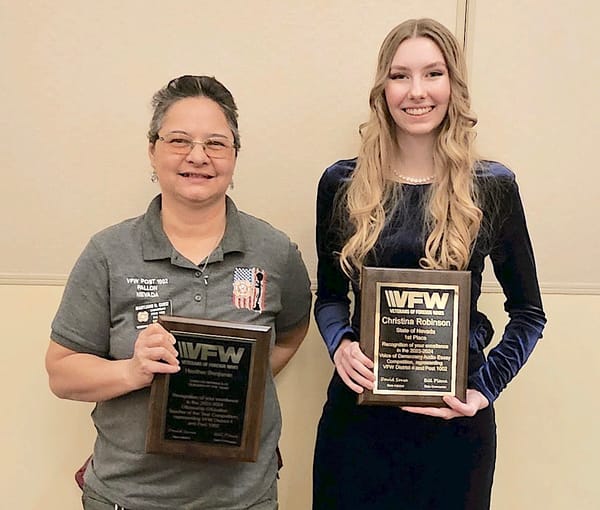Growth not paying for growth in Southern Nevada

Builders’ taxes and fees stagnant for decades as home sales soar
By Dana Gentry, Nevada Current
This story was originally published by Nevada Current.
LAS VEGAS–America’s top home builders are enjoying near-record post-recession sales in Nevada, home to three of the top selling master planned communities in the nation, and where a shortage of inventory and construction backlogs have buyers engaged in bidding wars. It’s the same in much of the nation, as real estate proves the bright spot of the pandemic.
But the axiom that growth pays for growth is anathema in Southern Nevada, where builders are enjoying tax rates circa the Bush era. Make that both Bush eras.
“When you go to buy a home, the home builder is the last point of connection,” explains Amanda Moss, government affairs director of the Southern Nevada Home Builders’ Association, which represents 90 percent of home builders in the market. “There are also administrative taxes, every document that gets transferred, local government processing fees, the liability of employment, paid sick leave, wages, getting your laborers to show up.”
The list is, indeed, exhaustive. But the fees and taxes paid by developers to local governments for the privilege of doing business have remained stagnant for decades.
The Residential Construction Tax, a $1,000 per unit assessment earmarked for parks, was established in 1987.
A nominal $683 fee per unit that Clark County charges builders in fast-growing southwest Las Vegas to provide infrastructure such as roads, parks, police and fire stations, was set in 2001. On Monday, it will inch up $250 for the first time in two decades and increase another $700 in July.
“A phased in approach. The market could not absorb the increase” at one time, says Moss. She acknowledges the fees and taxes assessed developers for infrastructure “have not kept pace with inflation.”
The increase in fees has been on the table since March 2019, when County Commissioners learned the so-called Public Facility Needs Assessment (PFNA) fees collected from builders since 2001 fall far short of providing the necessary facilities and infrastructure.
“Eighteen years is a little long,” without an adjustment, Clark County Comprehensive Planning Director Nancy Amundsen told the Commission in March 2019. “I’ll be honest with you. When I came here in 2006, at one point they talked about reevaluating in five years, but that never came to fruition. There wasn’t the appetite. Then we had the downturn.”
Southern Highlands developer Gary Goett built a fire station and threw in a fire engine as part of his development agreement negotiated with the county in 1998, but PFNA fees collected in the last two decades for a second fire station — estimated to cost between $7.5 million and $10 million — amount to only $1 million.
“So, it’s not a substantial amount of money,” Amundsen said at that same 2019 commission meeting, noting the county’s fees on a single family residence would have to jump 41.9 percent to keep pace with inflation. “Right now we could not even afford one-seventh of a fire station in the southwest based on these fees.”
As of 2019, West Henderson’s PFNA fees on a single family residence totaled $2,205.
“Our fees are about a quarter of that right now,” Amundsen said in 2019. Two nominal increases followed.
In 2001, the county projected 61,000 housing units and 150,000 residents by 2018 in southwest Las Vegas. By 2019, residential units surpassed the 72,000 mark and the number of residents – 180,000 — exceeded projections by 20 percent. Still, the county’s fee collections from developers fizzled — amounting to $1.3 million for transportation infrastructure and just $500,000 for a police substation during the 18 year span.
Only fees collected for parks, which are coupled with other sources, have proved substantial enough to be put to use, Amundsen told her bosses in 2019.
“Growth is not paying for growth,” complains Southern Highlands resident Mike Kosor, who has become a thorn in the side of the County Commission.
He says the county’s PFNA program is “poorly concocted and administered,” and was “neglected for two decades. The fees attached to new construction today are now grossly deficient in meeting the cost to provide the public infrastructure the county’s growth has created.”
Kosor says the increases slated this year are not enough.
He’s lobbied county officials to impose impact fees, a mechanism approved by state lawmakers in 1989 but rarely employed in Southern Nevada. Kosor says the fees would place more financial burden on builders but provide up-front funding for amenities. It would also put builders, many of whom opt for negotiated development agreements, on equal footing.
In 2007, the Southern Nevada Home Builders Association torpedoed an effort by local governments in Southern Nevada to assess impact fees of $2,600 per home and an equivalent amount for other new development, according to legislative minutes and news reports. The SNHBA complained money raised in one area of town would be spent elsewhere.
“There’s a fair way to do it so it benefits the homeowner,” Irene Porter, then-executive director of the association, told the Las Vegas Sun at the time.
Why did the home builders block the effort?
Partly power, partly fear of a state money grab, says one former elected official who spoke on the condition of anonymity.
“Developers think they’ve got more control over local elected officials, so they want to keep it local. The concern is that if the Legislature authorized impact fees, it will ultimately be a source to deal with state needs,” the former official said.
Additionally, Nevada is governed by Dillon’s Rule, which limits the powers of counties to those expressly granted by the Legislature. Cities created by charter, such as Reno, have less restraint under Dillon’s Rule, and have enjoyed greater success imposing impact fees.
While Nevada law allows impact fees, unlike other states, it prohibits the fees from paying for school construction in large counties.
“From a credit standpoint, impact fees are a crummy credit,” says public finance expert Guy Hobbs. “You’d have to couple them with other revenues in order to bond against it.”
A 2019 legislative effort to allow impact fees to pay for school construction died without a hearing.
Kosor points to the current effort to raise sales and gaming taxes to pay for schools.
“Why turn to little people to pay taxes when they can’t afford it?” he asks. “They could look to these homebuilders who are having the best time ever. Why doesn’t the county have a bill draft request to raise the Residential Construction Tax to pay for parks?”
“I raised the issue of the RCT cap more than once over the past two years,” says Clark County Commissioner Justin Jones, who notes the $1,000 per unit cap “was set in 1987 and hasn’t been adjusted in the past 34 years. Meanwhile, construction costs and home values have increased substantially.”
The buyer of a $100,000 home pays the same RCT as the buyer of a $1,000,000 home.
“I do think that it is inequitable that the cap favors higher-end properties who can afford the pass-along cost most, and at the expense of home affordability,” says Jones.
Unlike taxes, impact fees don’t generate revenue and they aren’t paid by everyone. They cover the cost of infrastructure, are paid by developers and presumably passed through to homebuyers, who benefit from the improvements. The fee can’t exceed the cost of providing the service.
Kosor says the county has failed to provide any correlation between the cost of providing services and the fees charged developers.
“Why do we have so many pots of money when the dollars can work together?” asks Moss of the SNHBA. “What we support is the number one thing the county can do is consolidate the parks districts.”
“Why not make it a two mile radius.” she suggests. “Then the dollars can combine instead of trying to find these missing dollars somewhere.”
Moss says Jones has raised the prospect of a hike in the RCT. She says addressing funding for parks is the “first thing we should do before we push more Southern Nevadans out of the market by putting an increased tax on home building.”
Moss says the SNHBA is also looking at property tax reform.
“The property tax rate cap for 115 districts are not at their max,” she said.
Kosor calls the SNHBA’s support for a property tax increase “more cost-shifting. It shifts who pays for public infrastructure needs that their growth requires.”
“New home construction generates $23.8 million in taxes and other revenue for local governments,” the Nevada Home Builders Association website says.
The SNHBA sources the figure to a 2014 study, but says it does not track taxes and was unable to provide a breakdown.
Nevada’s Commerce Tax, the mechanism designed to capture corporate revenue generated in the state, assesses the construction industry a .083 percent tax on gross revenue over $4,000,000. Only three industries, mining, agriculture, and one category of transportation, enjoy lower tax rates.
A variety of other taxes, such as the Modified Business Tax on employees, may be deducted to reduce the liability.
Let’s make a deal
“The Home Builders have a proposal that could create a lot of additional revenue,” Jones declared at a County Commission meeting in December, after proposing the increase in PFNA fees.
Clark County is in danger of losing millions of dollars in a ‘use it or lose it’ reserve account that builders fund to ensure Building Department staff stay on the job in the event of a recession.
The SNHBA is working with Assemblyman Steve Yeager on a bill that would allow Clark County to sidestep that law and put a portion of the money, about $11 million, toward fire stations.
“They have to come up with creative ways to spend it or return it,” Moss says. “Rather than create new capital projects that aren’t sitting there, why can’t we use some of that to offset PFNAs?”
“It’s our intent to build one of the fire stations in the southwest,” Moss says, adding the bill may not pass, forcing the SNHBA and the County “back to the drawing board and see how these items are going to get paid for.”
Building boom
The nation’s top home builders have historically held a disproportionate share of the Nevada market, in part because smaller builders succumbed to the cost of construction defect premiums and claims.
Between 2000 and 2012, Nevada’s top ten builders increased market share from 36 percent to 78 percent, according to a 2014 study prepared by UNLV for the Nevada Home Builders Association.
By contrast, the top ten builders accounted for only a quarter of the national market in 2010 and 2011, according to Builder Magazine.
New home sales in Southern Nevada peaked in 2005 when builders sold 35,051 units.
Last year, Southern Nevada home builders sold 11,000 homes. The median price of $415,000 in October set an all-time record.
“Since the pandemic started, we’ve seen a $15,000 to $45,000 instant cost increase to construction,” Moss says, citing materials that are delayed.
Orders for new homes from Lennar, among the top three home builders in America, grew 16 percent in the fourth quarter of 2020 from the previous year.
Lennar’s annual revenue of $22.5 billion was up from $22.3 billion the previous year. The builders’ homes in the western U.S. reaped the largest average sales price in the third quarter at $552,000, followed by the Central U.S. at $380,000. Lennar homes in Texas averaged the lowest price at $274,000.
KB Homes, also one of the top three home builders, has 32 communities in Las Vegas. The company reported “a near-standstill in housing starts in the second quarter of 2020,” because of the pandemic. The average price of a KB home increased five percent year-to-year to $414,000.
“When you talk about developers making all this money, when you see a story that says we’re doing well, prices are increasing because the bottom of the market is not financially secure enough to qualify for the prices,” says Moss.
“When we talk about affordability challenges, raising the cost of new construction is not the answer,” says Moss, who adds for every $1,000 price increase, 2,200 Southern Nevadans are priced out of the market.
“The builders will tell you impact fees make housing more expensive. It will drive up costs and reduce affordable housing,” says Kosor. “That’s bull, because the cost of housing is driven by the market, not the cost of the house.”
“If the builder has to pay ten percent more for a house, that doesn’t mean the cost of the house will go up ten percent,” he says. “It may go up, but so will mine.”





